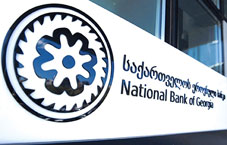
Georgian Banks suffer record GEL747 million in first quarter of 2020
By Natalia Kochiashvili
Friday, April 24
The 15 commercial banks operating in Georgia lost a total of GEL747 million in the first quarter of 2020, according to statistics released by the National Bank of Georgia (NBG). This is the largest loss rate in the history of these statistics.
From the financial indicators, it is clear that the main reason for the loss was the reserve by the banks for possible losses of GEL1.2 billion. In total, Georgian commercial banks have saved GEL1.22 billion in the ‘possible losses of assets’ buffer, which reflects the amount of possible losses on loans due to the expected crisis.
Georgian Banking Association (GBA) explained that the damage was caused by “the creation of a surplus reserve, and it is irrelevant to talk about the fact that this reserve is actually being realized and it will be more or less than that.” According to GBA president, Aleksandre Dzneladze, all commercial banks have held reserves and in the NBG’s indicators, the profit is reduced to the direct reserves.
Other points in the statistics of commercial banks' financial indicators show that, as of the first quarter, the revenues of Georgian banks remain stable. Moreover, all major indicators have improved compared to 2019. Among them, compared to the previous year, the total income received by banks has increased by 15.8% and it amounts to GEL1.2 billion.
The NBG made a special explanation regarding these statistics as well, noting that in previous years, the sector has been highly profitable, allowing banks to create adequate volumes of buffers, the use of which is important in such crisis situations.
Statement reads, that the operating profit of the first quarter of the banking sector amounted to GEL386 million. The net profit of banks is negative and minus GEL747 million, which is only 1.5% of total assets. This is mainly due to the creation of reserves for negative expectations from COVID-19. The banking sector, as of March, had possible losses of $1.2 billion in loans reserve and this number represents only a potential (and not sold) loss. The reserve in the event of the loss actually occurs in the future, banks will be able to avoid the financial stability risks.
In the previous periods, the banking sector was profitable, notes NBG. In 2019, the industry’s average annual profit (ROE) was 20%, which allowed banks to raise the capital adequacy ratio (CAR) to a high level. At the same time, the NBG imposed additional capital requirements on banks, which created a fairly large capital buffer in the industry to deal with a similar stressful situation.
At the same time, the NBG eased capital requirements for banks. This change involved the abolition of the capital conservation buffer (2.5% of the weighted assets at risk) and the elimination of part of the Pillar 2 buffer (2/3 of the non-hedged credit risk buffer). Therefore GEL1.6 billion of capital back was released to banks in March and expressed readiness, if necessary, for additional capital release.
With the release of this released capital, there are far more reserves that will allow banks to handle even more negative developments.
At the same time, the average annual profit of the banking sector in recent years was GEL900 million, in 2020 only, the first 3 months of operating profit is GEL386 million. Due to the increased credit losses, the net profit of banks this year may be negative, predicts NBG. However, given these decent operating incomes, it is expected that after the transition to the pandemic, banks will soon regain profitability.
Statement also emphasized that financial statements of a commercial bank consistently reflect the real financial condition of the bank. Special attention is paid to the quality of assets.
“In terms of transparency, the Georgian banking system is one of the best and all stakeholders have the opportunity to receive important and timely information about banks,” notes the letter, adding that it’s the reason why the banking sector has often been the object of unfair criticism (so-called high profitability), while other economic entities fail to ensure a high level of transparency and, thus, avoid criticism.
NBG reiterated its prudent regulatory policies of the current year, the potential losses in order to neutralize large buffers are available, and the banking sector's stability is not in danger.
As of now, the volume of overdue loans in the Georgian banking system is one of the lowest in the region, accounting for 1.37% of the total portfolio, or GEL437 million.


